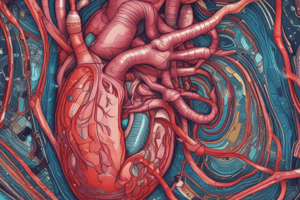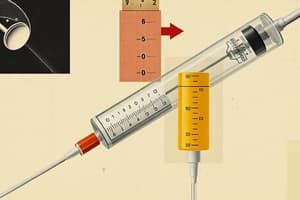Podcast
Questions and Answers
Which type of drug is responsible for dilation when it acts as an agonist?
Which type of drug is responsible for dilation when it acts as an agonist?
- Constricting Drug
- Parasympathetic Agonist
- Parasympathetic Antagonist
- Sympathetic Agonist (correct)
What effect does a parasympathetic agonist typically have on blood vessels?
What effect does a parasympathetic agonist typically have on blood vessels?
- Dilation
- Mixed effect
- No effect
- Constriction (correct)
Which of the following drugs would likely lead to vasodilation?
Which of the following drugs would likely lead to vasodilation?
- Parasympathetic Agonist
- Constricting Drug
- Parasympathetic Antagonist (correct)
- Sympathetic Antagonist
In the context of the autonomic nervous system, what is the primary role of sympathetic agonists?
In the context of the autonomic nervous system, what is the primary role of sympathetic agonists?
Which of the following drugs primarily acts as a sympathomimetic agent to induce pupil dilation?
Which of the following drugs primarily acts as a sympathomimetic agent to induce pupil dilation?
Which of these medications is classified as a parasympathetic antagonist used for pupil dilation?
Which of these medications is classified as a parasympathetic antagonist used for pupil dilation?
What is the primary mechanism of action of cocaine concerning pupil dilation?
What is the primary mechanism of action of cocaine concerning pupil dilation?
Which of the following drugs can be classified as a pupil constrictor?
Which of the following drugs can be classified as a pupil constrictor?
Identify the drug that acts as a parasympathetic agonist, leading to pupil constriction.
Identify the drug that acts as a parasympathetic agonist, leading to pupil constriction.
Which drug is a parasympathetic antagonist that causes pupil dilation?
Which drug is a parasympathetic antagonist that causes pupil dilation?
Which of the following is a sympathetic agonist that promotes the release of norepinephrine?
Which of the following is a sympathetic agonist that promotes the release of norepinephrine?
Which of these drugs acts by blocking norepinephrine reuptake in the synapse?
Which of these drugs acts by blocking norepinephrine reuptake in the synapse?
What class of drugs primarily contributes to pupil dilation through an anticholinergic mechanism?
What class of drugs primarily contributes to pupil dilation through an anticholinergic mechanism?
Which of the following is a pupil constricting drug that acts as an opioid?
Which of the following is a pupil constricting drug that acts as an opioid?
Flashcards
Sympathetic Agonists (dilation)
Sympathetic Agonists (dilation)
Drugs that mimic sympathetic nervous system actions, causing dilation.
Parasympathetic Antagonists (dilation)
Parasympathetic Antagonists (dilation)
Drugs that block parasympathetic actions, leading to dilation.
Parasympathetic Agonist (constriction)
Parasympathetic Agonist (constriction)
Drugs mimicking parasympathetic nerves, causing constriction.
Dilating drugs
Dilating drugs
Signup and view all the flashcards
Constricting drugs
Constricting drugs
Signup and view all the flashcards
Phenylephrine
Phenylephrine
Signup and view all the flashcards
Atropine
Atropine
Signup and view all the flashcards
Pilocarpine
Pilocarpine
Signup and view all the flashcards
Cocaine
Cocaine
Signup and view all the flashcards
Opioids/Narcotics
Opioids/Narcotics
Signup and view all the flashcards
Pupil Dilation
Pupil Dilation
Signup and view all the flashcards
Sympathetic Agonists
Sympathetic Agonists
Signup and view all the flashcards
Parasympathetic Antagonists
Parasympathetic Antagonists
Signup and view all the flashcards
Pupil Constriction
Pupil Constriction
Signup and view all the flashcards
Study Notes
Sympathetic Agonists (Dilation)
- Phenylephrine
- Apraclonidine
- Amphetamine: Increases norepinephrine (NA) release
- Cocaine: Blocks NA reuptake from synapse
Parasympathetic Antagonists (Dilation)
- Atropine
- Homatropine
- Tropicamide
Parasympathetic Agonist (Constriction)
- Pilocarpine
Dilating Drugs
- Nasal decongestants
- Epinephrine, phenylephrine, etc.
- Anticholinergics
- Antidepressants
Constricting Drugs
- Opioids/narcotics
- Heroin
Studying That Suits You
Use AI to generate personalized quizzes and flashcards to suit your learning preferences.
Related Documents
Description
This quiz explores the pharmacological effects of different drugs on the sympathetic and parasympathetic systems, focusing on agents that cause dilation and constriction. Key substances such as phenylephrine, atropine, and pilocarpine are highlighted, along with their mechanisms. Test your knowledge on these critical concepts in pharmacology!





